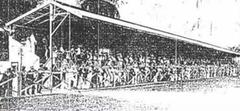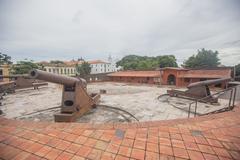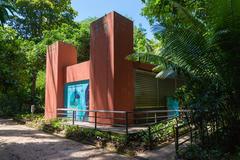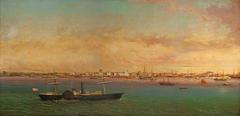
Memorial da Cabanagem: Visiting Hours, Tickets, and Comprehensive Guide to Belém’s Historical Landmark
Date: 04/07/2025
Introduction: Historical Significance of the Memorial da Cabanagem
The Memorial da Cabanagem in Belém, Pará, stands as a powerful tribute to one of Brazil’s most consequential popular uprisings—the Cabanagem revolt (1835–1840). This modernist monument, designed by Oscar Niemeyer, honors the memory of the caboclos, Indigenous peoples, and freed slaves who rose against systemic exclusion and injustice in the Amazon region. The conflict resulted in a tragic loss of life, with estimates of 30,000 to 40,000 deaths—nearly 40% of the province’s population at the time (Official Pará Tourism).
Located at the Entroncamento viaduct, a major urban gateway in Belém, the Memorial combines symbolic architecture with educational exhibits and artistic elements, such as Marianne Peretti’s evocative stained-glass window. The site is accessible and free to the public, underscoring its role as both a place of remembrance and a cultural hub. This guide offers comprehensive visitor information, including opening hours, ticket policies, accessibility, nearby attractions, and practical tips to ensure a meaningful visit (Museus PA, O Liberal).
Table of Contents
- The Cabanagem Uprising: Origins and Impact
- Visiting the Memorial da Cabanagem: Essential Information
- Modernist Architecture and Symbolism
- On-Site Experience: What to See & Do
- Special Events and Cultural Programming
- Practical Travel Tips
- Nearby Historical and Cultural Attractions
- Frequently Asked Questions (FAQ)
- Plan Your Visit and Further Resources
The Cabanagem Uprising: Origins and Impact
The Cabanagem revolt erupted in 1835 in the then-province of Grão-Pará, driven by deep socio-economic inequalities and political exclusion following Brazil’s independence. The term “Cabanagem” derives from “cabana”—the simple huts of the region’s poorest inhabitants along the Amazon’s rivers. The insurgency, led by figures such as Clemente Malcher, Francisco Vinagre, and Eduardo Angelim, succeeded in briefly capturing Belém and establishing a provisional government. However, internal divisions and overwhelming imperial force led to its suppression, leaving a legacy of resistance and a profound human cost (Official Pará Tourism).
The conflict is significant not just for its scale, but for its enduring role in shaping regional identity and highlighting the struggles of marginalized Amazonian communities (Agência Pará).
Visiting the Memorial da Cabanagem: Essential Information
Location and Accessibility
- Address: Entroncamento Viaduct, Belém, Pará (Complexo Viário do Entroncamento)
- Access: Easily reached by public transportation, taxi, or car; approximately 8 km from the historic center and 12 km from Belém/Val-de-Cans International Airport.
- Facilities: Wheelchair-accessible ramps, paved paths, security, restrooms, vending machines.
Opening Hours and Admission
- Hours: Tuesday to Sunday, 8:00 AM – 6:00 PM (closed Mondays for maintenance)
- Tickets: Free admission year-round, including during special events (Secult PA, O Liberal)
- Guided Tours: Regular guided tours are not offered, but special events may include educational activities and guided visits (G1 Pará)
Modernist Architecture and Symbolism
The Memorial da Cabanagem, inaugurated in 1985, is the only Oscar Niemeyer-designed structure in northern Brazil. The site consists of:
- Monumental Ramp: A 15-meter-high by 20-meter-long concrete blade, symbolizing the rebels’ ascent and the enduring quest for freedom (Ricardo Condurú, Monumentos de Belém)
- Crypt-Museum: Beneath the monument lies a crypt intended to house the remains (some symbolic) of five key leaders—Batista Campos, Eduardo Angelim, Francisco Vinagre, Antônio Vinagre, and Félix Clemente Malcher.
- Stained Glass by Marianne Peretti: A luminous window with a suspended crystal teardrop, representing Pará’s collective mourning.
- Reflecting Pool and Landscaped Grounds: These elements metaphorically evoke Amazonian rivers and provide a tranquil setting (Museus PA).
The architectural design is not only visually striking but deeply symbolic, integrating the region’s history and aspirations into every element.
On-Site Experience: What to See & Do
- Explore the Monument: Walk the ramp and appreciate the interplay of light, shadow, and space.
- Visit the Crypt-Museum: View the tombs, stained glass, and crystal teardrop.
- Historical Exhibits: Examine panels with period newspaper clippings, a model of 19th-century Belém, and displays about the revolt and the memorial’s construction.
- Photography: Capture the dramatic architecture and vibrant stained glass, especially during early morning or late afternoon.
- Self-Guided Exploration: Informational signage is primarily in Portuguese—translation apps are recommended for non-Portuguese speakers.
Special Events and Cultural Programming
The Memorial da Cabanagem is a focal point for commemorative and cultural events, particularly during January’s Preamar Cabano festival (January 6th–31st):
- Exhibitions: Art, documents, and multimedia on the Cabanagem and Pará’s history.
- Workshops & Lectures: Historical document analysis, talks by local historians, and public readings.
- Film Screenings: Documentaries and artistic projections, such as the “A Cabanagem” video mapping.
- Book Fairs & Public Activities: Collaborative events with local institutions.
All events are free; schedules are updated on the Secult portal and Agência Pará.
Practical Travel Tips
- Best Time to Visit: Early morning or late afternoon for cooler temperatures and optimal lighting.
- Dress: Light, breathable clothing; bring water and sunscreen due to Belém’s hot, humid climate.
- Language: Most signage is in Portuguese; consider a translation app or local guide for context.
- Safety: The site is generally safe during the day, with security present. Avoid isolated areas after dark.
- Accessibility: The revitalized grounds feature ramps and accessible pathways, though some uneven surfaces may remain.
- Parking: Limited on-site; public transit or taxis are recommended, especially during festivals.
Nearby Historical and Cultural Attractions
Combine your visit to the Memorial da Cabanagem with:
- Forte do Presépio: A 17th-century fort and museum.
- Ver-o-Peso Market: One of Latin America’s largest open-air markets, offering Amazonian products and local cuisine.
- Theatro da Paz: A neoclassical theater and architectural gem.
- Museu do Estado do Pará: Exhibiting regional art and history.
All are accessible within a short drive or via public transportation, enriching your cultural itinerary in Belém.
Frequently Asked Questions (FAQ)
Q: What are the Memorial da Cabanagem’s opening hours?
A: Tuesday to Sunday, 8:00 AM – 6:00 PM; closed on Mondays.
Q: Is there an entrance fee?
A: No, admission is free.
Q: Are guided tours available?
A: Guided tours are not routinely offered but may be available during special events.
Q: Is the site accessible for visitors with disabilities?
A: Yes, there are ramps and accessible pathways, though some surfaces may be uneven.
Q: How do I get to the Memorial from the airport?
A: It’s a 15–20 minute taxi ride from Belém/Val-de-Cans International Airport, or accessible via public buses to the Entroncamento.
Q: What is the best time of year to visit?
A: January, during the Preamar Cabano festival, or during cooler morning and late afternoon hours.
Plan Your Visit and Further Resources
The Memorial da Cabanagem is an essential destination for those seeking to understand the Amazon’s history, its people’s resilience, and the art of Oscar Niemeyer. Its accessibility and free admission make it welcoming to all. For updated information on hours, events, and guided activities, consult the Secult PA, Museus PA, and Agência Pará.
Enhance your experience by downloading the Audiala app for interactive tours, following us on social media, and exploring related guides to Belém’s historical sites and Brazilian modernist architecture.
Reliable Sources and Further Reading
- Official Pará Tourism
- Museus PA – Memorial da Cabanagem
- Monumentos de Belém
- O Liberal – Monument Reopening
- Agência Pará – Preamar Cabano
- Secult PA
- Ricardo Condurú – Project History







